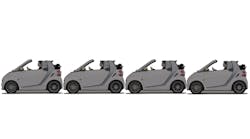Liberal arts and those phantom traffic jams
Several readers from the liberal-arts side of the house defend that line of study as a valid way to gain entry to high-tech jobs and industries. And an engineering reader offers a more-straightforward cure for phantom traffic jams: Pay attention to the traffic up ahead.
Liberal arts Rule
I am a liberal-arts major (BA & MA in English) in his 34th year working in what was once called the power-transmission industry. I can say I have been served very well by my education (“Those Deadbeat Liberal-Arts Students,” Dec. 12.)
I am currently a sales and marketing manager for a Japanese company that makes rotary sensors but my past experience has included gearmotors, clutches, roller chains, and drives.
Toward the end of my senior year in high school, my advisor asked if I had plans for a college major. After telling him I was not sure, he suggested I try English, as he felt I had some writing skill. He said that no matter what profession I ended up in, a major in English would let me read and write better than my bosses. He was correct, of course, and the communication education I received has contributed to my success.
I liked your editorial and noticed in the end that you believe there is a place for some liberal arts in this world. That was a nice twist. In my meetings with global manufacturing leaders, there are plenty of talented engineers. I have watched the growth of the U. S. electric-vehicle industry from its inception. I do not see a dearth of engineers. They may come from other countries to provide the labor necessary to make the world’s largest economy continue to hum just as diverse groups have come in earlier centuries to build roads and railroads to work in steel mills. The jobs are filled and more will be hired in the years ahead as the economy continues to improve. They may come from other countries and the faces are quite diverse, but they are Americans now.
Charlie Nash
I know plenty of liberal-arts majors who made it big financially in the business world. Having a liberal-arts degree does not disqualify one from participating in the economic process. I also know a lot of people who succeeded in engineering and technical disciplines without an engineering degree. The biggest factor is being willing to learn and having a drive to compete. Formal education is a rather ancillary thing.
Stephen Stoneski
The cure for phantom traffic jams
Many years ago, probably around 1970, I recall reading about the work of engineering students in a similar study of traffic backups and chain-reaction crashes on the Long Island Expressway (“Algorithm Solves Problems of Phantom Traffic Jams,” Dec. 12). An observation point was selected on an overpass in an area where rush-hour backups were common. After some observation, it was discovered that the propagating effect of a spurious brake application was mathematically similar to force-wave propagation in a coil spring.
It was also discovered that the wave effect was disrupted, or even eliminated, by a driver monitoring conditions a few cars ahead, with the distance/reaction-time the significant factor rather than the distance to the car in front or the number of cars. An alternative damping effect was for a driver to leave more space between himself and the car in front, somewhat akin to the basis of bilateral control. But in practical applications like the Long Island Expressway or any highway in Rhode Island, the car behind is most likely glued to the back bumper of the car in front and the space in front would instantly be filled by a car swerving in from the next lane, which would necessitate brake application and initiate the next event.
It would seem that the prevention of these phantom events is more a function of anticipation and controlled reaction to events in front, rather than bilateral control, because a driver can only control his car and not the one following. Monitoring events in front lets drivers dampen their reactions so the guys behind don’t need to overreact. I would suggest that rather than becoming “bilaterally” concerned about the cars behind, a system that monitors events some number of cars/distance in front would go a long way to eliminating or at least shortening these phantom jams.
Robert Brandrif
